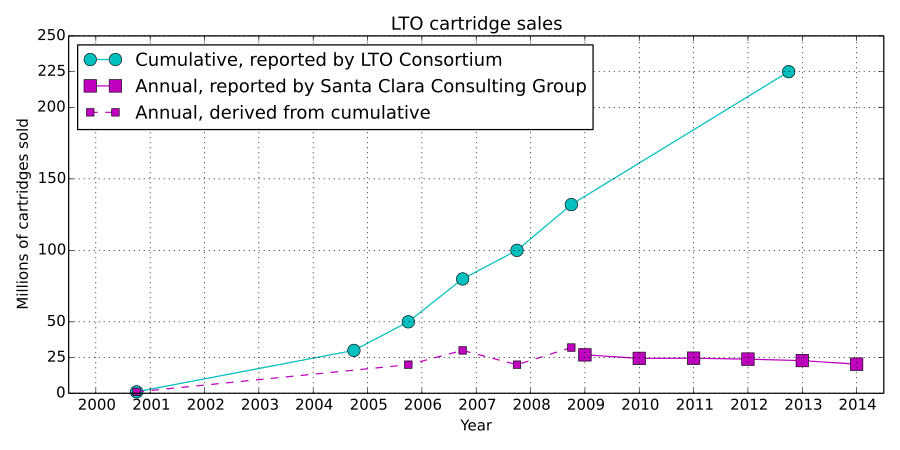Linear Tape-Open
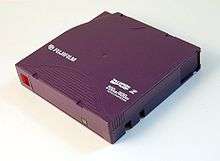
Linear Tape-Open (LTO) is a magnetic tape data storage technology originally developed in the late 1990s as an open standards alternative to the proprietary magnetic tape formats that were available at the time. Hewlett-Packard, IBM and Quantum control the LTO Consortium, which directs development and manages licensing and certification of media and mechanism manufacturers.
The standard form-factor of LTO technology goes by the name Ultrium, the original version of which was released in 2000 and can hold 100 GB of data in a cartridge. The seventh generation of LTO Ultrium was released in 2015 and can hold 6.0 TB in a cartridge of the same size.
Upon introduction, LTO Ultrium rapidly defined the super tape market segment and has consistently been the best-selling super tape format.[1][2] LTO is widely used with small and large computer systems, especially for backup.
Historical context
Half-inch (½-inch, 12.65 mm) magnetic tape has been used for data storage for more than 60 years. In the mid 1980s, IBM and DEC put this kind of tape into a single reel, enclosed cartridge. Although the physical tape was nominally the same size, the technologies and intended markets were significantly different and there was no compatibility between them. IBM called its format 3480 (after IBM's one product that used it) and designed it to meet the demanding requirements of its mainframe products. DEC originally called theirs CompacTape, but later it was renamed DLT and sold to Quantum Corporation. In the late 1980s, Exabyte's Data8 format, derived from Sony's dual-reel cartridge 8 mm video format, saw some popularity, especially with UNIX systems. Sony followed this success with their own now-discontinued 8 mm data format, Advanced Intelligent Tape (AIT).
By the late 1990s, Quantum's DLT and Sony's AIT were the leading options for high-capacity tape storage for PC servers and UNIX systems. These technologies were (and still are) tightly controlled by their owners. Consequently, there was little competition between vendors and the prices were relatively high.
To counter this, IBM, HP and Seagate formed the LTO Consortium, which introduced a more open format focusing on the same mid-range market segment.[3] Much of the technology is an extension of the work done by IBM at its Tucson lab during the previous 20 years.[4] Initial plans called for two LTO formats to directly compete with these market leaders: Ultrium with half-inch tape on a single reel, optimized for high-capacity and Accelis with 8 mm tape on dual-reels, optimized for low-latency.
Around the time of the release of LTO-1, Seagate's magnetic tape division was spun off as Seagate Removable Storage Solutions, later renamed Certance, which was subsequently acquired by Quantum.
Generations

Despite the initial plans for two form-factors of LTO technology, only Ultrium was ever produced. In common usage, LTO generally refers to the Ultrium form factor.
As of 2015, seven generations of LTO Ultrium technology have been made available and three more are planned. Between generations, there are strict compatibility rules that describe how and which drives and cartridges can be used together.
| LTO-1 | LTO-2 | LTO-3 | LTO-4 | LTO-5 | LTO-6 | LTO-7 | LTO-8 | LTO-9 | LTO-10 | |
|---|---|---|---|---|---|---|---|---|---|---|
| Release date | 2000[5] | 2003 | 2005 | 2007 | 2010[6] | Dec. 2012[7] | Dec. 2015[8][9][10] | TBA | TBA | TBA |
| Native/raw data capacity | 100 GB | 200 GB | 400 GB | 800 GB | 1.5 TB[11] | 2.5 TB[12] | 6.0 TB[10][13] | 12.8 TB[13] | 26 TB[14] | 48 TB[14] |
| Max uncompressed speed (MB/s)[13][Note 1] | 20 | 40 | 80 | 120 | 140 | 160 | 300[15] | 427 | 708 | 1100 |
| Compression capable? | Yes, "2:1" | Yes, "2.5:1" | Planned, "2.5:1"[14][16] | |||||||
| WORM capable? | No | Yes | Planned | |||||||
| Encryption capable? | No | Yes | Planned | |||||||
| Max. number of partitions | 1 (no partitioning) | 2 | 4 | Planned | ||||||
| ||||||||||
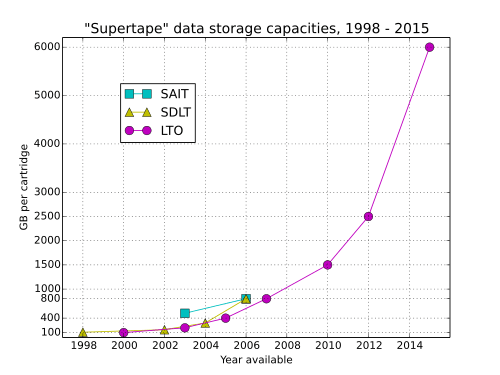
- Notes
- Data capacity and speed figures above are for uncompressed data. Most manufacturers list compressed capacities on their marketing material. Capacities are often stated on tapes as double the actual value; they assume that data will be compressed with a 2:1 ratio (IBM uses a 3:1 compression ratio in the documentation for its mainframe tape drives. Sony uses a 2.6:1 ratio for SAIT). See Compression below and the table above.
- The units for data capacity and data transfer rates generally follow the "decimal" SI prefix convention (e.g. mega = 106) and not the binary prefix convention (e.g. mega = 220).
- Minimum and maximum reading and writing speeds are drive-dependent.
Compatibility
In contrast to other tape technologies, an Ultrium cartridge is rigidly defined by a particular generation of LTO technology and cannot be used in any other way. While Ultrium drives are also defined by a particular generation, they are required to have some level of compatibility with older generations of cartridges. The rules for compatibility between generations of drives and cartridges is as follows:
- An Ultrium drive can read data from a cartridge in its own generation and the two prior generations.
- An Ultrium drive can write data to a cartridge in its own generation and to a cartridge from the immediate prior generation in the prior generation format.
- An Ultrium drive cannot make any use of a cartridge from a more recent generation.
For example, an LTO-2 cartridge can never be used by an LTO-1 drive and even though it can be used in an LTO-3 drive, it performs as if it were in an LTO-2 drive.
Within the compatibility rules stated above, drives and cartridges from different vendors are expected to be interchangeable. For example, a tape written on any one vendor's drive should be fully readable on any other vendor's drive that is compatible with that generation of LTO.
Core technology
Tape specifications
| Generations | LTO-1 | LTO-2 | LTO-3 | LTO-4 | LTO-5 | LTO-6 | LTO-7 | LTO-8 | LTO-9 | LTO-10 |
|---|---|---|---|---|---|---|---|---|---|---|
| Native data capacity | 100 GB | 200 GB | 400 GB | 800 GB | 1.5 TB[11] | 2.5 TB[12][17] | 6.0 TB[10][13][17] | 12.8 TB[13][17] | 26 TB[14][16][17] | 48 TB[14][17] |
| Tape length | 609 m | 680 m | 820 m | 846 m[18] | 960 m | |||||
| Tape width | 12.650 mm ± 0.006 mm | |||||||||
| Tape thickness | 8.9 µm | 8 µm | 6.6 µm | 6.4 µm | 6.1 µm[19] | 5.6 µm | ||||
| Magnetic pigment material | Metal Particulate (MP) | MP or BaFe[20] | BaFe[21] | |||||||
| Base material | Polyethylene naphthalate (PEN) | |||||||||
| Data bands per tape | 4 | |||||||||
| Wraps per band | 12 | 16 | 11 | 14 | 20[11] | 34 | 28 | |||
| Tracks per wrap (read/write elements) | 8 | 16[11][22] | 32 [10] | |||||||
| Total tracks | 384 | 512 | 704 | 896 | 1280 | 2176[22] | 3584 | |||
| Linear density (bits/mm) | 4880 | 7398 | 9638 | 13,250 | 15,142[23] | 15,143[24] | 19,094[25] | |||
| Encoding | RLL 1,7 | RLL 0,13/11; PRML | RLL 32/33; PRML | 32/33 RLL NPML[24] | ||||||
| End-to-end passes required to fill tape |
48 | 64 | 44 | 56 | 80 | 136 | 112 | |||
| Expected tape durability, end-to-end passes |
9600 [26] | 16,000 [26] | 16,000 [26] | 11,200 [26] | 16,000 [26] | |||||
Physical structure
LTO Ultrium tape is laid out with four wide data bands sandwiched between five narrow servo bands. The tape head assembly, that reads from and writes to the tape, straddles a single data band and the two adjacent servo bands. The tape head has 8, 16, or 32 data read/write head elements and 2 servo read elements. The set of 8, 16, or 32 tracks read or written in a single, one-way, end-to-end pass is called a "wrap". The tape head shifts laterally to access the different wraps within each band and also to access the other bands.
Writing to a blank tape starts at band 0, wrap 0, a forward wrap that runs from the beginning of the tape (BOT) to the end of the tape (EOT) and includes a track that runs along one side of the data band. The next wrap written, band 0, wrap 1, is a reverse wrap (EOT to BOT) and includes a track along the other side of the band. Wraps continue in forward and reverse passes, with slight shifts toward the middle of the band on each pass. It is important to note that the tracks written on each pass partially overlap the tracks written on the previous wrap of the same direction, like roof shingles. The back and forth pattern, working from the edges into the middle, conceptually resembles a coiled serpent and is known as linear serpentine recording.
When the first data band is filled (they are actually filled in 3, 1, 0, 2 order across the tape), the head assembly is moved to the second data band and a new set of wraps is written in the same linear serpentine manner. The total number of tracks on the tape is (4 data bands) × (11 to 34 wraps per band) × (8, 16, or 32 tracks per wrap). For example, an LTO-2 tape has 16 wraps per band, and thus requires 64 passes to fill.
Logical structure
The block structure of the tape is logical so interblock gaps, file marks, tape marks and so forth take only a few bytes each. In LTO-1 and LTO-2, this logical structure has CRC codes and compression added to create blocks of 403,884 bytes. Another chunk of 468 bytes of information (including statistics and information about the drive that wrote the data and when it was written) is then added to create a 'dataset'. Finally error correction bytes are added to bring the total size of the dataset to 491,520 bytes (480 KB) before it is written in a specific format across the eight heads. LTO-3 and LTO-4 use a similar format with 1,616,940-byte blocks.[27]
The tape drives use a strong error correction algorithm that makes data recovery possible when lost data is within one track. Also, when data is written to the tape it is verified by reading it back using the read heads that are positioned just 'behind' the write heads. This allows the drive to write a second copy of any data that fails the verify without the help of the host system.
Positioning times
While specifications vary somewhat between different drives, a typical LTO-3 drive will have a maximum rewind time of about 80 seconds and an average access time (from beginning of tape) of about 50 seconds.[28] Because of the serpentine writing, rewinding often takes less time than the maximum. If a tape is written to full capacity, there is no rewind time, since the last pass is a reverse pass leaving the head at the beginning of the tape (number of tracks ÷ tracks written per pass is always an even number).
Tape durability
LTO tape is designed for 15 to 30 years of archival storage.[29][30] Depending on the generation of LTO technology, a single LTO tape should be able to sustain approximately 200-364 full file passes.[26]
There is a large amount of lifespan variability in actual use. One full file pass is equal to writing enough data to fill an entire tape and takes between 44 and 136 end-to-end passes. Regularly writing only 50% capacity of the tape results in half as many end-to-end tape passes for each scheduled backup, and thereby doubles the tape lifespan. LTO uses an automatic verify-after-write technology to immediately check the data as it is being written,[31][32] but some backup systems explicitly perform a completely separate tape reading operation to verify the tape was written correctly. This separate verify operation doubles the number of end-to-end passes for each scheduled backup, and reduces the tape life by half.
Optional technology
The original release of LTO technology defined an optional data compression feature. Subsequent generations of LTO have introduced new optional technology, including WORM, encryption, and partitioning features.
Compression
The original LTO specification describes a data compression method LTO-DC, also called Streaming Lossless Data Compression (SLDC).[33][34] It is very similar to the algorithm ALDC[35] which is a variation of LZS. LTO-1 through LTO-5 are advertised as achieving a "2:1" compression ratio, while LTO-6 and LTO-7,[10] which apply the same compression algorithm to larger blocks of data, are advertised as having a "2.5:1" ratio. This is inferior to slower algorithms such as gzip, but similar to lzop and the high speed algorithms built into other tape drives.
The primary difference between ALDC and SLDC is that SLDC does not apply the compression algorithm to incompressible data (i.e. data that is already compressed or sufficiently random to defeat the compression algorithm). Every block of data written to tape has a header bit indicating whether the block is compressed or raw. For each block of data that the algorithm works on, it saves a copy of the raw data. After applying the compression function to the data, the algorithm compares the "compressed" data block to the raw data block in memory and writes the smaller of the two to tape. The extra bit used by SLDC to differentiate between raw and compressed blocks effectively places an upper bound on the expansion of incompressible data.
WORM
New for LTO-3 was write once read many (WORM) capability. This is normally only useful for legal record keeping. An LTO-3 or later drive will not erase or overwrite data on a WORM cartridge, but will read it. A WORM cartridge is identical to a normal tape cartridge of the same generation with the following exceptions: the cartridge memory identifies it to the drive as WORM, the servo tracks are slightly different to allow verification that data has not been modified, the bottom half of the cartridge shell is gray,[36] and it may come with tamper-proof screws.[37] WORM-capable drives immediately recognize WORM cartridges and include a unique WORM ID with every dataset written to the tape. There is nothing different about the tape medium in a WORM cartridge.
Encryption
The LTO-4 specification added a feature to allow LTO-4 drives to encrypt data before it is written to tape.[38] All LTO-4 drives must be aware of encrypted tapes, but are not required to actually support the encryption process. All current LTO manufacturers support encryption natively enabled in the tape drives using Application Managed Encryption (AME). The algorithm used by LTO-4 is AES-GCM, which is an authenticated, symmetric block cipher. The same key is used to encrypt and decrypt data, and the algorithm can detect tampering with the data. Tape drives, tape libraries, and backup software can request and exchange encryption keys using either proprietary protocols, or an open standard like OASIS's Key Management Interoperability Protocol.
Partitioning
The LTO-5 specification introduced the partitioning feature that allows a tape to be divided into two separately writable areas, known as partitions. LTO-6 extends the specification to allow 4 separate partitions.
Linear Tape File System
The Linear Tape File System (LTFS) is a self-describing tape format and file system made possible by the partition feature. File data and filesystem metadata are stored in separate partitions on the tape. The metadata, which uses a standard XML schema, is readable by any LTFS-aware system and can be modified separately from the data it describes. The Linear Tape File System Technical Work Group of the Storage Networking Industry Association (SNIA) works on the development of the format for LTFS.[39]
Without LTFS, data is generally written to tape as a sequence of nameless "files", or data blocks, separated by "filemarks". Each file is typically an archive of data organized using some variation of tar format or proprietary container formats developed for and used by backup programs. In contrast, LTFS utilizes an XML-based index file to present the copied files as if organized into directories. This means LTFS-formatted tape media can be used similarly to other removable media (USB flash drive, external hard disk drive, and so on).
While LTFS can make a tape appear to behave like a disk, it does not change the fundamentally sequential nature of tape. Files are always appended to the end of the tape. If a file is modified and overwritten or removed from the volume, the associated tape blocks used are not freed up: they are simply marked as unavailable, and the used volume capacity is not recovered. Data is deleted and capacity recovered only if the whole tape is reformatted.
In spite of these disadvantages, there are several use cases where LTFS-formatted tape is superior to disk and other data storage technologies. While LTO seek times can range from 10 to 100 seconds, the streaming data transfer rate can match or exceed disk data transfer rates. Additionally, LTO cartridges are easily transportable and hold far more data than any other removable data storage format. The ability to copy a large file or a large selection of files (up to 1.5 TB for LTO-5 or 2.5 TB for LTO-6) to an LTFS-formatted tape, allows easy exchange of data to a collaborator or saving of an archival copy.
Since LTFS is an open standard, LTFS-formatted tapes are usable by a wide variety of computing systems.
Cartridges
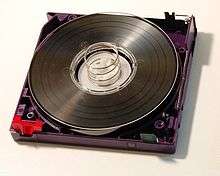
Top right corner: tape access gate.
Bottom left corner: write-protect-tab.
Bottom right corner: cartridge memory chip
Compliance-Verified licensed manufacturers of LTO technology media are EMTEC, Imation, Fujifilm, Maxell, TDK and Sony.[40] All other brands of media are manufactured by these companies under contract. Since its bankruptcy in 2003, EMTEC no longer manufactures LTO media products. TDK[41] withdrew from the data tape business in 2014. Verbatim[42] and Quantegy[43] both licensed LTO technology, but never manufactured their own compliance-verified media.
In addition to the data cartridges, there are also Universal Cleaning Cartridges (UCC), which work with all drives.
| UCC | LTO-1 | LTO-2 | LTO-3 | LTO-4 | LTO-5 | LTO-6 | LTO-7 | LTO-8 | LTO-9 | LTO-10 | |
|---|---|---|---|---|---|---|---|---|---|---|---|
| Dimensions [44] | 102.0 × 105.4 × 21.5 mm | ||||||||||
| Cartridge memory | 4 KB | 8 KB | 16 KB[22]:5[45] | ||||||||
| Typical color | Black | Black | Purple | Slate-blue / Blue-gray | Green / Green-gray / Teal | Dark red[46] | Black[47] | Purple[48] | |||
| HP color | Orange | Blue | Dark red | Yellow | Green[49] | Light blue[50] | Purple[51] | Slate blue[52] | |||
Colors
The colors of LTO Ultrium cartridge shells are mostly consistent, though not formally standardised. HP is the notable exception. Sometimes similar, rather than identical, colors are used by different manufacturers (slate-blue and blue-gray; green, teal, and blue-green).
WORM (write once, read many) cartridges are two-tone, the top half of the shell is the normal color of that generation for that manufacturer, and the bottom half of the shell is a light gray.
 HP's dark red LTO-2 cartridge
HP's dark red LTO-2 cartridge HP's light-blue LTO-5 cartridge
HP's light-blue LTO-5 cartridge
Cartridge memory
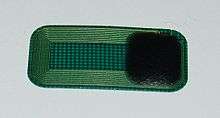
Every LTO cartridge has a cartridge memory chip inside it. It is made up of 511, 255, or 128 blocks of memory, where each block is 32 bytes for a total of 16 KB for LTO-6 and 7; 8 KB for LTO-4 and 5; and 4 KB on LTO-1 to 3 and cleaning cartridges.[45] This memory can be read or written, one block at a time, via a non-contacting passive 13.56 MHz RF interface. This memory is used to identify tapes, to help drives discriminate between different generations of the technology, and to store tape-use information.
Every LTO drive has a cartridge memory reader in it. The non-contact interface has a range of 20 mm.[53] External readers are available, both built into tape libraries and PC based. One such reader, Veritape, connects by USB to a PC and integrates with analytical software to evaluate the quality of tapes.[54] This device is also rebranded as the Spectra MLM Reader[55] and the Maxell LTO Cartridge Memory Analyzer.[56]
Labels
The LTO cartridge label uses the bar code symbology of USS-39. A description and definition is available from the Automatic Identification Manufacturers (AIM) specification Uniform Symbol Specification (USS-39) and the ANSI MH10.8M-1993 ANSI Barcode specification.
Leader pin

The tape inside an LTO cartridge is wound around a single reel. The end of the tape is attached to a perpendicular leader pin that is used by an LTO drive to reliably grasp the end of the tape and mount it in a take-up reel inside the drive. Older single-reel tape technologies, such as 9 track tape and DLT, used different means to load tape onto a take-up reel.
When a cartridge is not in a drive, the pin is held in place at the opening of the cartridge with a small spring. A common reason for a cartridge failing to load into a drive is the misplacement of the leader pin as a result of the cartridge having been dropped. The plastic slot where the pin is normally held is deformed by the drop and the leader pin is no longer in the position that the drive expects it to be.
Erasing
The magnetic servo tracks on the tape are factory encoded. Using a bulk eraser, degaussing, or otherwise exposing the cartridge to a strong magnetic field, will erase the servo tracks along with the data tracks, rendering the cartridge unusable.
Erasing the data tracks without destroying the servo tracks requires special equipment. The erasing head used in these erasers has four magnetic poles that match the width and the location of the data bands.
The gaps between the poles correspond to the servo tracks, which are not erased. Tapes erased by this equipment can be recorded again.[57]
Cleaning

Although keeping a tape drive clean is important, normal cleaning cartridges are abrasive and frequent use will shorten the drive's lifespan. LTO drives have an internal tape head cleaning brush that is activated when a cartridge is inserted. When a more thorough cleaning is required the drive signals this on its display and/or via Tape Alert flags.[58] Cleaning cartridge lifespan is usually from 15 to 50 cleanings. There are 2 basic methods of initiating a cleaning of a drive: robot cleaning and software cleaning.
In addition to keeping the tape drive clean, it is also important to keep the media clean. Debris on the media can be deposited onto drive components that are in contact with the tape. This debris can result in increased media wear that generated more debris.
Removing excessive debris from tape can reduce the number of data errors.
Cleaning of the media requires special equipment.[59]
These cleaners are also used by Spectra Logic to clean new media that is marketed as "CarbideClean" media.[60]
Mechanisms
Current Compliance-Verified licensed manufacturers of LTO technology mechanisms are IBM, Hewlett-Packard, Quantum, and Tandberg Storage.[40] The mechanisms, also known as tape drives or streamers, are available in Full-height and Half-height form factors. These drives are frequently packaged into external desktop enclosures or carriers that fit into a robotic tape library.
 IBM Full-Height LTO-2 drive
IBM Full-Height LTO-2 drive HP Half-Height LTO-2 drive in an enclosure for desktop use
HP Half-Height LTO-2 drive in an enclosure for desktop use Inside a LTO-2 tape drive
Inside a LTO-2 tape drive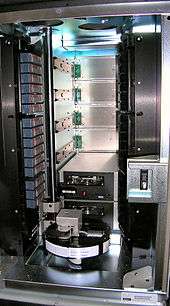 ADIC Scalar 100 tape library interior
ADIC Scalar 100 tape library interior- IBM 3584 tape library with LTO-1 (Ultrium) tapes visible
Market performance
LTO technology competes in the market against other tape technologies and hard disk technology. In the course of its existence, LTO has succeeded on both fronts, almost completely displacing all other mid-range and low-end tape technologies and preventing, or at least delaying, the predicted "death of tape"[61] at the hands of disk. At the high-end of the tape market, the IBM 3592 series and Oracle T10k series products are still viable and under active development.
Sales success
The presence of five certified media manufacturers and four certified mechanism manufacturers has produced a competitive market for LTO products. This has led to attractive prices for customers and high sales volumes for manufacturers. In 2002 LTO out-shipped SDLT by nearly 2 to 1. Sales since then have dominated other "super" formats (SDLT, SAIT). As a result, Quantum discontinued development of new DLT products in February 2007 and Sony followed suit by declaring AIT End-of-Life in March 2010.
As hard disk drive prices have dropped, disk has become cheaper relative to tape drives and cartridges. As of 2013 the cost of an LTO-5 drive taking tapes of up to 1.5 TB true (uncompressed) capacity was about US$1800. As of 2013 a tape cartridge is still cheaper than a disk drive, as a 1.5 TB magnetic tape cartridge costs about US$40 whereas a hard disk drive with the same capacity costs about US$70 to US$100.
Unsuccessful LTO variants
Some planned LTO variations were not produced, or produced only briefly.
Accelis
LTO technology was originally designed to come in two form factors, Ultrium and Accelis.[65] As of 2008 LTO Ultrium was very popular and there were no commercially available LTO Accelis drives or media.[66] In common usage, LTO generally refers only to the Ultrium form factor.
Accelis was developed in 1997 for fast access to data by using a two-reel cartridge that loads at the midpoint of the 8 mm wide tape to minimize access time. IBM's (short-lived) 3570 Magstar MP product pioneered this concept. The real-world performance never exceeded that of the Ultrium tape format, so there was never a demand for Accelis and no drives or media were commercially produced.
Multiple lengths of LTO-1 tapes
The first generation of Ultrium tapes were going to be available with four types of cartridge, holding 10 GB, 30 GB, 50 GB, and 100 GB. Only the full length 100 GB tapes were produced.[67]
HP LTO-1 cleaning strategy
HP LTO Gen.1 drives have a cleaning strategy[68] that will prevent the drive from actually using the cleaning tape if it is not needed. In a change of strategy, HP LTO Gen 2, 3 and 4 drives will always clean when a Universal Cleaning Cartridge is inserted, whether the drive requires cleaning or not.[68]
See also
References
- ↑ "Super tape drive shipments double in" (PDF). Archived from the original (PDF) on 2005-03-06. Retrieved 2013-03-29.
- ↑ "New Freeman Study Projects Major Shifts In Compact Tape — Industry Growth In Units, Revenue Seen" (PDF). Archived from the original (PDF) on 2005-03-06. Retrieved 2013-03-29.
- ↑ "HP, IBM, And Seagate Agree to Establish Open Format Specifications for Enterprise and Network Storage" (Press release). LTO. November 4, 1997. Archived from the original on 2006-11-13. Retrieved 2007-10-15.
- ↑ "IBM storage history". IBM. Retrieved 2013-03-29.
- ↑ "Linear Tape-Open Program Ships One Million Ultrium Tapes in First 12 Months of Availability for market" (PDF) (Press release). LTO. November 5, 2001.
- ↑ "LTO-5 expected in H1 2010 with 1.6 TB–3.2 TB storage". Geekzone.co.nz:80. Retrieved 2013-03-29.
- ↑ from Quantum and Tandberg, Bechtle Direct catalog 09/2012, p. 450
- ↑ "Quantum LTO-7 HH SAS internes Laufwerk (TC-L72AN-BR)". Retrieved 2015-12-27.
- ↑ Signoretti, Enrico (2015-09-21). "LTO-7 has it taped, but when will 'bigger/faster' thinking hit the buffers?". The Register. Retrieved 2015-09-24.
- 1 2 3 4 5 "The LTO Program Announces Upcoming Generation 7 Specifications for Licensing". 2015-09-14. Retrieved 2015-09-15.
- 1 2 3 4 "The Linear Tape File System". 2010.
- 1 2 "Licensing Specs for LTO-6 Available in August, 2012". Micro-Journal / The LTO Program.
- 1 2 3 4 5 "Ultrium Generations LTO". Hewlett-Packard, IBM and Quantum. Archived from the original on 2011-06-26.
- 1 2 3 4 5 Mellor, Chris (11 Sep 2014), "No TKO for LTO: Tape format spawns another 2 generations, sports 120 TB bigness", The Register
- ↑ Mellor, Chris (2015-09-16). "LTO issues mighty seventh-generation 15 TB tape format". The Register. Retrieved 2015-09-22.
- 1 2 Mellor, Chris (2010-04-15). "Two new LTO tape gens announced". The Register.
- 1 2 3 4 5 LTO Roadmap Extended To Gen 10
- ↑ Rivera, Rogelio; Vargas, Gustavo; Vázquez, Marco (September 2012), IBM® System Storage® LTO Ultrium 6 Tape Drive Tape Drive Performance White Paper (PDF), IBM Guadalajara,
This new capacity is achieved in the same tape length (846 m) as the gen5 media due to a higher density format (gen6 format).
Note that another IBM announcement disagrees: "This is achieved by increasing the linear density, track density, and the media length." (IBM TS1060 LTO-6 tape drive announcement, p. 3.) Note: the difference on the length from LTO5 and LTO6 media is only 1 m. - ↑ "Fujifilm LTO-6 specifications" (PDF). Retrieved 2013-03-29.
- ↑ Imation whitepaper: LTO-6 MP or BaFe?
- ↑ HP Ultrium Storage Supplies
- 1 2 3 IBM System Storage TS1060 Tape Drive offers an Ultrium 6 Tape Drive for the TS3500 Tape Library, IBM, 2012-10-03, IBM Hardware Announcement, retrieved 2012-11-05,
There are 2,176 data tracks in Ultrium 6 versus 1,280 data tracks in Ultrium 5.
- ↑ "LTO-5 Tape Drive User's Guide" (PDF). Quantum.
- 1 2 "LTO-6/LTO-5 Tape Drive Datasheet". Quantum.
- ↑ 485 kbit/in"LTO Ultrium 7" (PDF). Sony. 2016-04-04. Retrieved 2016-04-17.
- 1 2 3 4 5 6 "Expected Usage Life of Imation Media" (PDF). Imation. Retrieved 2013-07-16.
- ↑ "Patent application number 20090208018: Data Transfer Device". Faqs.org. Retrieved 2013-03-29.
- ↑ Dell PowerVaultTM 110T drive specification. Retrieved 2009-05-16.
- ↑ HP Ultrium Media QuickSpecs v13 (PDF), UK: CCI distribution, March 29, 2010, DA-11529.
- ↑ "Storage tek tape storage media LTO specs". Oracle and Sun. Sun. 2011-10-04. Retrieved 2013-03-29.
- ↑ "Primer 3". Ultrium – LTO Technology. LTO. 2010-04-04. Archived from the original on 2012-03-06. Retrieved 2013-03-29.
- ↑ News bytes (PDF), LTO, Jun 2011, archived from the original (PDF) on 2011-07-27.
- ↑ Standard, ECMA, 321
- ↑ Specification of SLDC (PDF), ECMA, 321.
- ↑ ALDC documentation, IBM, archived from the original on 2006-03-13.
- ↑ "Image of Dell LTO-3 WORM cartridge with gray bottom". Support.dell.com. 2012-06-06. Retrieved 2013-03-29.
- ↑ "HP Forum: LTO 3 WORM info". H30499.www3.hp.com. Retrieved 2013-03-29.
- ↑ LTO-4 encryption whitepaper (PDF), HP, p. 11, archived from the original (PDF) on 2013-11-12, retrieved 2013-03-29
- ↑ "Linear Tape File System (LTFS)". SNIA. Retrieved 20 November 2013.
- 1 2 "LTO Compliance-Verified Licencees". Ultrium. Archived from the original on 2006-11-13. Retrieved 2013-03-29.
- ↑ "Notice Concerning Dissolution of Consolidated Subsidiary Due to Business Withdrawal" (Press release). LTO. August 29, 2013.
- ↑ "Emtec, Imation, and Verbatim License Linear Tape-Open Technology" (PDF) (Press release). LTO. August 3, 1998.
- ↑ "Linear Tape-Open (LTO) Technology Continues Licensee Momentum with Signing of Fujitsu and Quantegy" (PDF) (Press release). LTO. October 21, 1998.
- ↑ "LTO cartridge specifications". USA: Fujifilm. Retrieved 2013-03-29.
- 1 2 "LTO Ultrium Data Cartridge". Fujifilm. Retrieved 2015-12-27.
- ↑ Dark Red Fujifilm LTO-5 cartridge, Fuji film, archived from the original (JPEG) on September 28, 2011
- ↑ "Black Imation LTO-6 WORM cartridge" (JPEG). Nov 2011. Retrieved 2013-03-29.
- ↑ "LTO Ultrium Tape Media". Retrieved 2015-12-27.
- ↑ "Green HP LTO4 cartridge" (GIF). AU: Tammex. Retrieved 2013-03-29.
- ↑ Lt Blue HP LTO5 WORM cartridge, Span, archived from the original on 2011-07-16.
- ↑ HP LTO‐6 Ultrium tape cartdrige (JPEG), EU: Misco.
- ↑ "HPE LTO-7 Ultrium 15 TB RW Data Cartridge". Retrieved 2015-12-27.
- ↑ "Fujitsu Cartridge Memory documentation" (PDF). US: Fuji film. Retrieved 2013-03-29.
- ↑ "VeriTape the trusted Cartridge Quality Analyzer". MP tapes. 2010-06-15. Retrieved 2013-03-29.
- ↑ "Spectra MLM Reader". Spectra logic. 2007-11-15. Retrieved 2013-03-29.
- ↑ "Maxell LTO Cartridge Memory Analyzer". US: Maxell. Archived from the original on 2013-03-05. Retrieved 2013-03-29.
- ↑ "MP Tapes - Secure Erase of Data Cartridges for Redeployment". eraser.mptapes.com. Retrieved 2016-04-14.
- ↑ Tape alert.
- ↑ "Tape Cleaner - The missing piece for a clean data center". cleaner.mptapes.com. Retrieved 2016-04-14.
- ↑ "Certified Tape Media - Spectra Logic". Spectra Logic. Retrieved 2016-04-14.
- ↑ Data Tape: Dying a Slow Death or Already Dead?
- ↑ "Freeman Reports". Archived from the original on May 11, 2013. Retrieved 2013-06-02.
- 1 2 Press releases, LTO consortium, archived from the original on May 17, 2007
- ↑ "Santa Clara Consulting Group - Tape tracker". Retrieved 2015-06-02.
- ↑ "Advanced Research, Exabyte, Matsushita, Mitsumi Electric and Otari License Linear Tape-Open Technology". Find articles. Retrieved 2013-03-29.
- ↑ "What Happened to Accellis?". Enterprise storage forum. 2002-09-11. Retrieved 2013-03-29.
- ↑ "Cartouches Ultrium" (EMTEC site offering LTO-1 tape cartridges in multiple sizes) (in French). RPS data. 2005-05-09. Archived from the original on 2005-05-09. Retrieved 2013-03-29.
- 1 2 "HP cleaning strategy" (PDF). Sundds LTO. Archived from the original (PDF) on 2012-02-19. Retrieved 2013-03-29.
External links
| Wikimedia Commons has media related to Linear Tape-Open. |
- IBM's LTO Redbook: IBM System Storage Tape Library Guide for Open Systems
- Linear Tape Open Consortium
- ECMA-319: Ultrium 1 Format
- IBM LTO Ultrium Cartridge Label Specification, Revision 6

